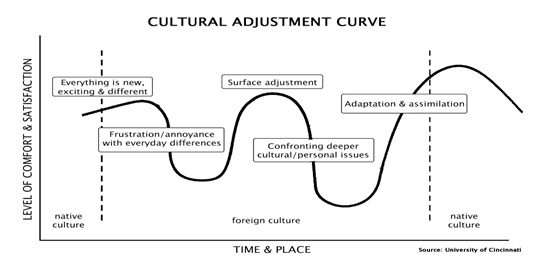Routines
When we first move across cultures many of our routines are disrupted: we eat different foods at different times of the day, we have to navigate a new environment, and we may be without a regular schedule for some time as we get settled. At the same time, even the most basic of routines, from turning on lights, to getting on a bus, to shopping at the grocery store – which we normally do on auto-pilot without much thinking, may suddenly require more (and in some cases our full) focus and energy.
Reactions
We do things we are accustomed to doing in our own culture – but we get a very different reaction than we expect in our new culture. While we recognize we probably acted out of the norm for the culture we are in, we don’t have the “key” to unlock this situation and understand exactly why people reacted the way they did. At the same time, we experience a different way of working, interacting or engaging. We ourselves try to react appropriately but find ourselves lacking the appropriate skills to do so effectively, be it a command of the language or the ability to shift styles.
Roles
We often experience changes in our roles and responsibilities when we move across cultures. We may carry out the same role but in another culture. We may take on a new or expanded role. We may lose roles that are important to us. We find some roles do not change, but our ability to fulfill these roles does. Additionally, others may see us as playing a particular role, whether or not we define ourselves in this way (e.g. the role of “a foreigner” or as a representative of your home culture). We are likely to experience many forms of role changes, sometimes simultaneously.
Relationships
When we move to another culture we discover how to live out our relationships in a new environment and are often challenged not to let the stresses around us enter into these relationships. Our relationships with those we transition with may get stronger, deeper and more profound as a result of going through the change, but they also take work. At the same time, we find other relationships around us changing—we may drift apart from certain friendships back home, be surprised at the newfound sense of closeness and kinship we experience with others despite the distance, and be challenged to recreate relationships in our new environment so we have a sense of community and support.
Reflections About Yourself
As we experience culture change, we may start to notice that we ourselves change in some subtle and not so subtle ways: we may realize we actually really enjoy certain aspects of the lifestyle abroad that we didn’t know we would; or, we realize just how important certain values are to us that we might not have articulated before. We may pick up certain habits, gestures, and ways of being that are now natural to us, but also may surprise and disarm family and friends back home who start to wonder what else has changed about us. We are growing, evolving, and developing—trying to become more aware of who we are culturally and individually speaking—which brings many benefits but often also some confusion and uncertainty.
